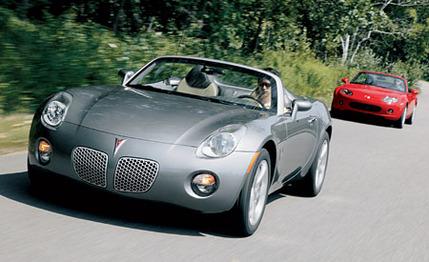
 Road Test
Road Test
We were worried in a big way, worried that the Pontiac Solstice would turn out to be a cost-cut, watered-down shell of the two Solstice concepts that debuted at the 2002 Detroit auto show. Those small, graceful two-seaters made the journey from doodle pad to rolling sheetmetal in an astonishing four months and drew attention away from the rolling Dumpster named for an indigenous people enchained by Hernando Cortés in 1521. Those show cars also served to demonstrate to the auto world that the appointment of retired Chrysler mogul Bob Lutz was more than just an attempt to pump up GM stock a quarter-point.
A drive of early prototypes suggested the car might survive GM's beancounters, but it still seemed far from being showroom-ready. We worried that delays would cost the Solstice the momentum and anticipation it had built. We worried when, at the last minute, a first drive of the Solstice was canceled. We worried that it would be less like a Mazda MX-5 Miata and more like a 1953 Corvette-all show with little go. Having been burned before, we remained as jaded and faithless as an abused dog.
Lutz, whose official title at GM these days is vice-chairman of global product development, says it cost about $250 million to bring the Solstice into the world, or what he described as the cost of a typical ad campaign. For that sum, GM created a new rear-drive platform called Kappa. That platform had to be inexpensive to engineer and build because a $20,000 price target for the Solstice was set early.
Engineers looked to the Corvette for inspiration and came up with an architecture that looks a lot like a naked Vette that just got out of a cold pool. Two hydroformed steel rails extend the length of the car and provide attachment points for the control-arm suspension used at all corners. Connecting the two rails are a fire wall and windshield frame, a bulkhead behind the seats, two floor pieces, and a centrally located boxed tunnel that ties the structure together. Each piece is then largely MIG-welded by hand. The labor-intensive frame provides a stiff structure that's as quiet and still as a stuffed dog.
But the Solstice doesn't benefit from many of the expensive weight-saving measures that go into the Corvette-the balsa floor and composite body panels, for example. The Solstice weighs a chubby 2888 pounds. If Mazda's new 2482-pound MX-5 and the Solstice were high-school wrestlers, they wouldn't be allowed to compete. But as affordable $20,000 roadsters, they will be locked in a tête-à-tête for the same customers.
Underhood, the Solstice has a 177-hp, 2.4-liter DOHC four-cylinder-an enlarged version of the 2.2-liter that pulls around sundry GM products. The Solstice has the first longitudinally mounted application of this four-cylinder family. Behind the engine is the five-speed manual from the Chevy Colorado pickup. To make it work in a sports car, throws were reduced and the linkage was altered to improve shift feel. The result is a gearbox that is easy to toss through the gears, and although it can't match the directness of the more expensive Honda S2000's, it's a willing ally. According to Lutz, draconian GM regulations that kept the pedals far apart from one another to avoid confusing the unwashed had to be suspended so sports-car faithful could properly carve corners. Now the pedals are set up perfectly for heel-and-toeing.